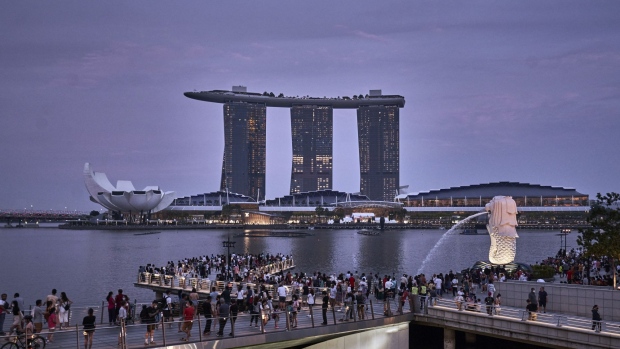Jan 12, 2023
Singapore's Art-Hub Ambitions Get Turbocharged by Record Wealth
, Bloomberg News

(Bloomberg) -- A new art fair will test Singapore’s efforts to establish itself as a major art hub, as record amounts of money flow into the city-state and traditional powerhouse Hong Kong continues to recover from years of strict pandemic measures.
Art SG, which began on January 12 and runs for four days, is Southeast Asia’s largest ever art fair and Asia Pacific’s biggest launch since Art Basel’s inaugural show in Hong Kong in 2013. Held in the Marina Bay Sands convention center, more than 160 galleries from 35 countries are attending, including names such as White Cube and David Zwirner, while novice collectors can peruse a section with art priced below $10,000.
The event marks the most serious attempt yet by Singapore to put itself on the global art scene after years of setbacks, with Art SG postponed four times due to Covid and organizational issues. In 2018, Art Basel parent MCH Group decided not to proceed with the fair due to cost cuts, before returning to buy a 15% stake in the organizer of Art SG last year. Another fair, Art Stage Singapore, was also abruptly canceled just days before its opening in 2019.
Art SG’s launch comes amid a rapid rise in wealth in the city-state over the course of the pandemic that is injecting new excitement into its art scene. Property prices have surged as wealthy expatriates from Hong Kong decamped to Singapore, while global investment banks and family offices set up shop or moved staff there.
The most visceral displays of new wealth in Singapore, however, come from the influx of rich Chinese who have been moving to the country in droves in the last few years, driven by strict Covid restrictions and tightening government control over the economy.
“Chinese collectors are incredibly important in Asia,” said Magnus Renfrew, Art SG’s co-founder and a veteran of the Asian art industry. “The strength of the Singapore-based Chinese community is a relatively recent phenomenon, so I think the fair is going to be one of the first times that the art market would have had an opportunity to engage with that community in a concentrated way.”
Southeast Asian art, including works by acclaimed Filipino painter Pam Yan Santos, will take center stage art Art SG, but more private collectors are getting hungrier for international art, said Lehmann Maupin’s Ken Tan, who was recently appointed the gallery’s first Southeast Asia director. At the first day of the fair, it sold $561,000 worth of art, including a work by an English artist to a Southeast Asia private collector for $86,000. Gagosian gallery placed two works by late artist Ashley Bickerton with Indonesia’s Museum MACAN for an undisclosed amount.
Read more: Seoul’s Inaugural Frieze Fair Opens to Strong Sales, Star Power
In financial terms, however, Singapore’s ambitions as a regional art hub may still have some way to go. The median expenditure of Hong Kong’s high-net-worth collectors for art and antiques was estimated at $633,000 in 2022, compared with $322,000 in Singapore, according to an Art Basel and UBS AG report.
And despite years of pandemic restrictions that kept Hong Kong almost isolated from the world, its grip on the Asian art market looks secure, not least as the city removed quarantine curbs in recent weeks — on the floor at Art SG, attendees discussed meeting up at Hong Kong’s Art Basel in March. And in a further signal of the art industry’s confidence in the Chinese city, auction houses Christie’s, Sotheby’s and Phillips are slated to open new and bigger headquarters there after record sales.
As a more established art market, Hong Kong also has other advantages over Singapore, such as more affordable and robust shipping, warehousing and high-security storage services, said Philip Hoffman, founder and chief executive of art advisory and investment firm The Fine Art Group. The city also has no customs duty, value-added taxes or estate duty on artworks.
Still, industry insiders say that some of the political and economic shifts in Hong Kong in recent years are here to stay and will have longer lasting effects on the art market.
“We all know that Hong Kong has various policies that are less international than before, which has impacted finance and art,” said Willa Dong, an art collector of more than 20 years and the director of a China-based gallery. Dong is preparing to open a Singapore gallery and has relocated to the city herself, alongside some of her clients.
“Of course we wish to collect and transact in a more transparent and free city,’’ she said.
©2023 Bloomberg L.P.


